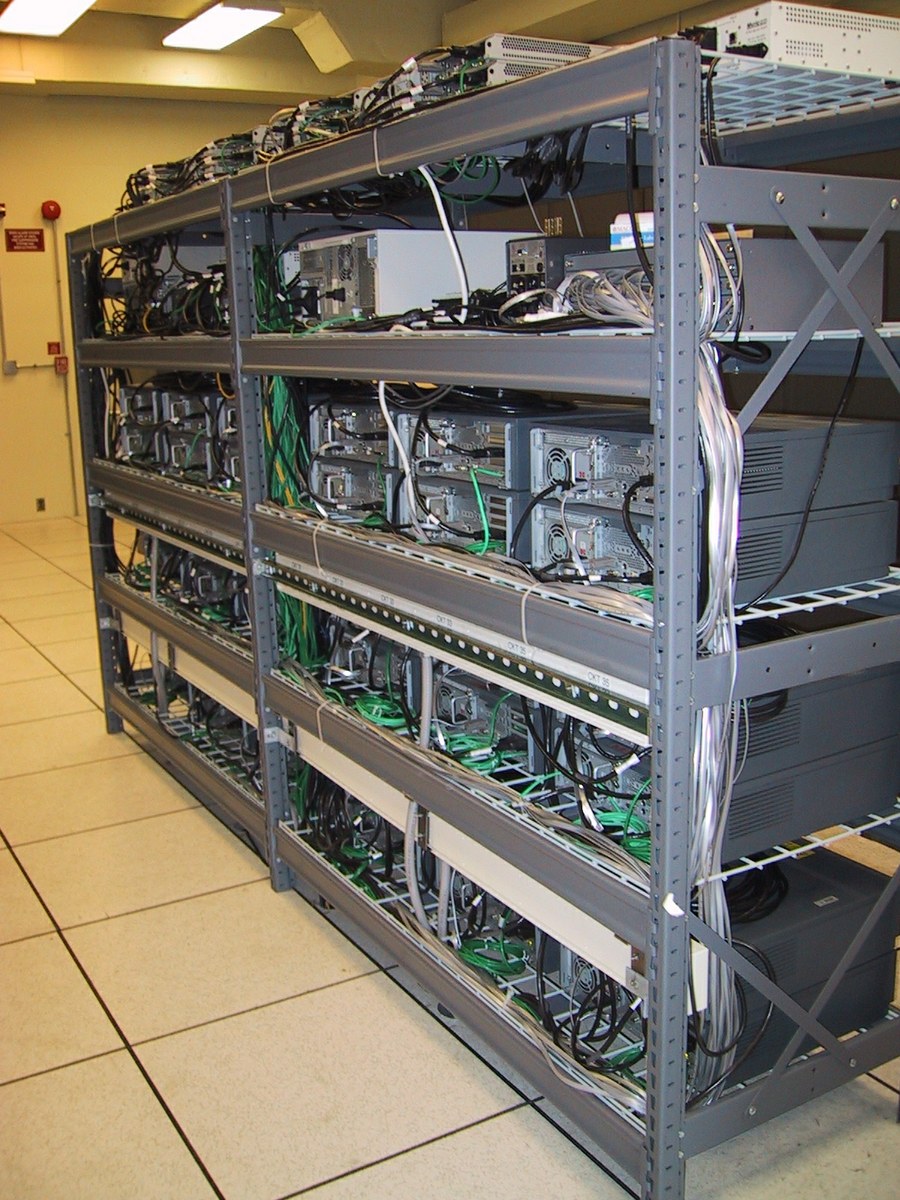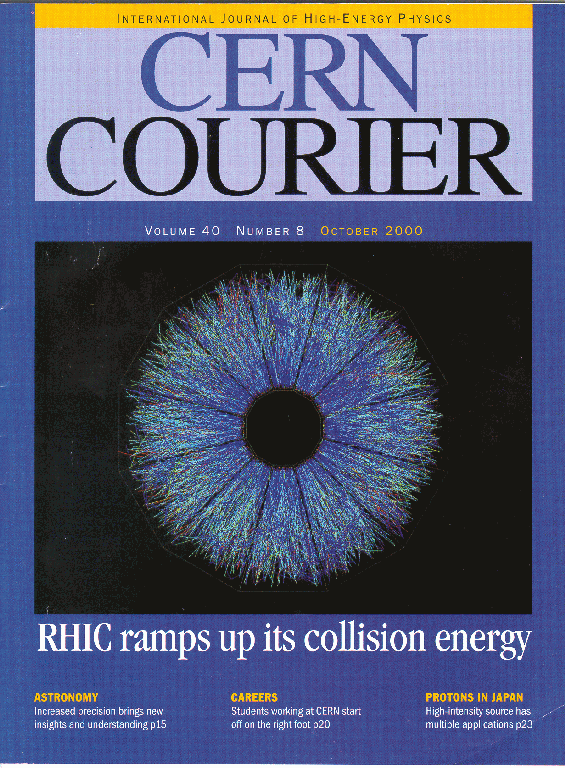A former project: the "Eye" Picture
This is the official WWW page of the STAR level-3 trigger system. It is the system, which has provided all pictures of high energy Au+Au collisions (where ''Au'' denotes an atomic gold nucleus) at the STAR experiment at the RHIC accelerator at Brookhaven National Laboratory, New York, USA. These pictures are sometimes called "eye" pictures, and they became one of the most cited pictures in high energy physics. The project was lead by Prof. Dr. Reinhard Stock from University of Frankfurt. In Brookhaven, the project leader (it means, as one of the subsystems of the STAR experiment) was Dr. Sören Lange, now at the II. Physics Institute of University of Giessen. Please find below the names of the involved students.
 | It is important to emphasize that he pictures on the right side ("eye" pictures) were actually not created for press releases, but they were part of a ''trigger'' system. It means, that the complete information about all particles in the event are processed online in order to make a decision, that this event is interesting (and thus recorded) or not interesting (and thus discarded). This decision took <120 ms time. After 1-2 more seconds, the information was tramsmitted to the STAR control room and displayed on a plasma screen. |
|---|
STAR means Solenoid Tracker at RHIC, which refers to the fact, that it is a detector for charged particle tracks in a magnetic solenoid field. RHIC means Relativistic Heavy Ion Collider. See here and here for more information.
The particle detector, which is visible on the pictures, is called a TPC (Time Projection Chamber) . The STAR TPC had an outer radius of 2 metres and a length (in beam direction) of 4 metres, so it is a very large gas-filled cylinder. If a charged particle trasverses the TPC, it creates ionisation along its path, and this ionisation creates the detectable signal, which is read out at the two ends of the TPC (it means, the ionisation cloud must travel up to 2 metres to the ends). The ends are equipped with "pads" detecting the charge.
Inspecting the event pictures further, you can see several different things.
You can see "points". Each point is a fired pixel in the TPC. The total number is 24 sectors x 5692 r/phi pads x 350 time bins = 47,812,800 pixels.
You can see "tracks". These are pathes of charged particles in the TPC detector, and each path has about 45 points. The tracks are reconstructed in realtime (in <120 milliseconds after the collision) by our level-3 trigger system. The the reconstructed track parameters (mathematically described by a helix) were sent to a display in the control room.
On some pictures, you can see "boxes". These are additional detectors integrated in the system and described below.
Hardware and Team
The hardware of the system was based upon 48 machines of thy type ALPHA DS10 by the company Digital. These were boxes which looked like PCs, but inside they had RISC architecture CPU chips. The main reason that we have chosen such hardware, was that an sqrt() function was implemented on ALPHA architecture as opcode (it means, as an assembler statements). PCs (Intel or AMD architecture) don't have such a feature. As the CPU had to run algorithms which calculated distances in Euklidian space, a huge amount of calculations such as sqrt(x^2+y^2) had to be performed. We compared it to a PC of same clock frequency, and the ALPHA was faster was the same track finder test program by ~50%.
The second important hardware component was MYRINET, a high bandwidth network technology, which is shown below.
Fig. 1 shows the back side of the farm with all MYRINET high speed network adapters. Fig. 2 shows the front of the farm.
Fig. 3 shows the team in front of the prototype farm with 12 ALPHAs in 1999 (from left a summer student from Rice University in Texas, Sören Lange, Jens Berger, Clemens Adler, Christoph Struck and Dominik Flierl).
Fig. 4 shows the team in front of the complete farm with 48 ALPHAs in 2003 (from left: Sören Lange, Clemens Adler, Jens Berger, Christoph Struck, Thomas Dietel).
Additional Detectors
Fig. 1 shows the electromagnetic calorimeter for a proton-proton collisions at 200 GeV with two jets (visible by the azimuthal back-to-back topology).
Fig. 2 shows the Silicon Vertex Tracker (SVT) and the Forward TPC (Time Projection Chamber) for a Au+Au collision at 200 GeV.
For the RICH (Ring Imaging Cerenkow Detector) an extrapolation algorithmus was implemented for pointing and matching of tracks of charged particles from the TPC onto the surface of the RICH detector (shown in Fig. 3).
In addition to beam collisions, also cosmic events were recorded with the level-3 trigger. Fig. 4 a collision of a very high energetic cosmic muon with material (supposedly the concrete wall) above the TPC detector.
Events of different types
Fig. 1: The calibration of the TPC was performed using an ultra-violet laser beam, inducing ionisation in the chamber. The challenge for the Level-3 trigger system was here to provide a track finder and track fitter for straight tracks (or, in other words, a curvature of infinity).
Fig.2: Collision events were triggered in synchronisation with a timing signal from the RHIC accelerator. From time to time it happened, that this timing signal was off by one particle bunch in the accelerator. In such a case a gap in the center of the TPC (by a timing offset for the readout) was observed.
Fig. 3: Background events occured, when beam particles hit the beampipe at a position of +-4 metres (correponding to the location, where the redius of the beampipe was reduced by a factor 2).
Fig. 4: At high luminosities (it means, at a high rate of collisions) pile-up events occured, in which 2 or more events are visible in the same event. Here you can see one p+p events at 200 GeV in the left TPC half and one in the right TPC half. The challenge for the level-3 track finder algorithm was, to identify two different primary vertices.
Journals
The level-3 trigger event pictures were published in several scientific and non-scientific journals and newspapers. Examples are shown here:
Fig. 1 CERN Courier
Fig. 2 Journal of Physics G (this is the original, which we provided to the editors of J. Phys. G, and which was then copied by many other journals)
Fig. 3 Nuclear Physics News International
Fig. 4 New York Times, June 16, 2000
First Collisions
|
The first RHIC Au+Au collisions were recorded in June 2000. The figure shows the STAR control room just 2-3 minutes after the first collision. On the left side, at the wall, see the level-3 trigger display with the event displayed on a plasma screen (for which, in the year 2000, the cost was around 15.000 US$). |
Ultraperipheral Collisions
|
The level-3 trigger system was also used extensively for events, which have not a few thousand charged tracks - but only two. For these events (called ultraperipheral) the two gold nuclei are not colliding, but instead by passing close to each other, they create an electromagnetic field with a virtual photon, which produces a rho meson. This particle has a mass of about 770 MeV and the same quantum numbers as the photon. It decays into two light mesons, a pi+ and a pi-. Fig. 1 and Fig. 2 show the first rho->pi+pi- event at STAR in a side view and front view, respectively. Fig. 3 shows the team (at 4 am) when recoding the event, with the online display at the wall. From the left: Akio Ogawa, Jens Berger, Spencer Klein, Clemens Adler, Sören Lange. |
Algorithms
Fig. 1 shows an important parameter called dE/dx, as a function of the momentum of a charged particle, in a comparison between the level-3 trigger and the offline analysis (which of course needs a few months after the recording of the event). The deposited energy (dE) is calculated from the ionization in the TPC. The path length (dx) is calculated from the recontructed track parameters. It means, that the online tracking algorithm entered the calculation of dx, and showed only a slightly worse resolution than for offline analysis. This technique was used for the online identification of Anti-Helium. Fig. 2 shows the Anti-He candidates.
Fig. 3 shows an example for a simple trigger task: distinguish events which pass close to (x,y)=(0,0), supposedly collision events, from cosmic events which may pass at any point in the TPC.Fig. 4 shows a bit more sophisticated trigger algorithm, triggering on two electrons with very high momentum. These are candidate events for heavy Upsilon states, which contain a heavy beauty and anti-beauty quark, and are very interesting, because they must be formed in a very early stage of the collision, when the temperature is more then 10^12 Kelvin.
Electronics
The network for data transmission between all level-3 trigger nodes was called MYRINET. It achieved a bandwidth of 120 MB/s. This bandwidth is comparable to Gigabit Ethernet, but with one major difference: MYRINET was able to perform DMA (direct memory access). This means, that for copying of large data blocks the CPU is not occupied by interrupt handling, and is thus free (e.g., for track finding and track fitting).
Fig. 1 shows the MYRINET PCI adapter. Fig. 2 shows the MYRINET PMC adapter. Fig. 3 shows the MYRINET switch.
|
Selected publications about the STAR level-3 trigger system.
J. S. Lange et al., The STAR Level-3 Trigger System, NIM A 453(2000)397 [pdf] J. S. Lange (corresponding author) at al., The STAR Level-3 Trigger System, NIM A 499(2003)778 [pdf] J. S. Lange, C. Struck, Anti-d and Anti-He Production in Au+Au Collisions at RHIC, arXiv:nucl-ex/0403008
J. S. Lange, Au+Au Collisions at RHIC and implications for ultra-relativistic astrophysical A+A collisions, arXiv:hep-ex/0411060 L3 Operation HOWTO [www] Ph. D. Theses |
|
A few interesting facts are probably widely unknown: |





















